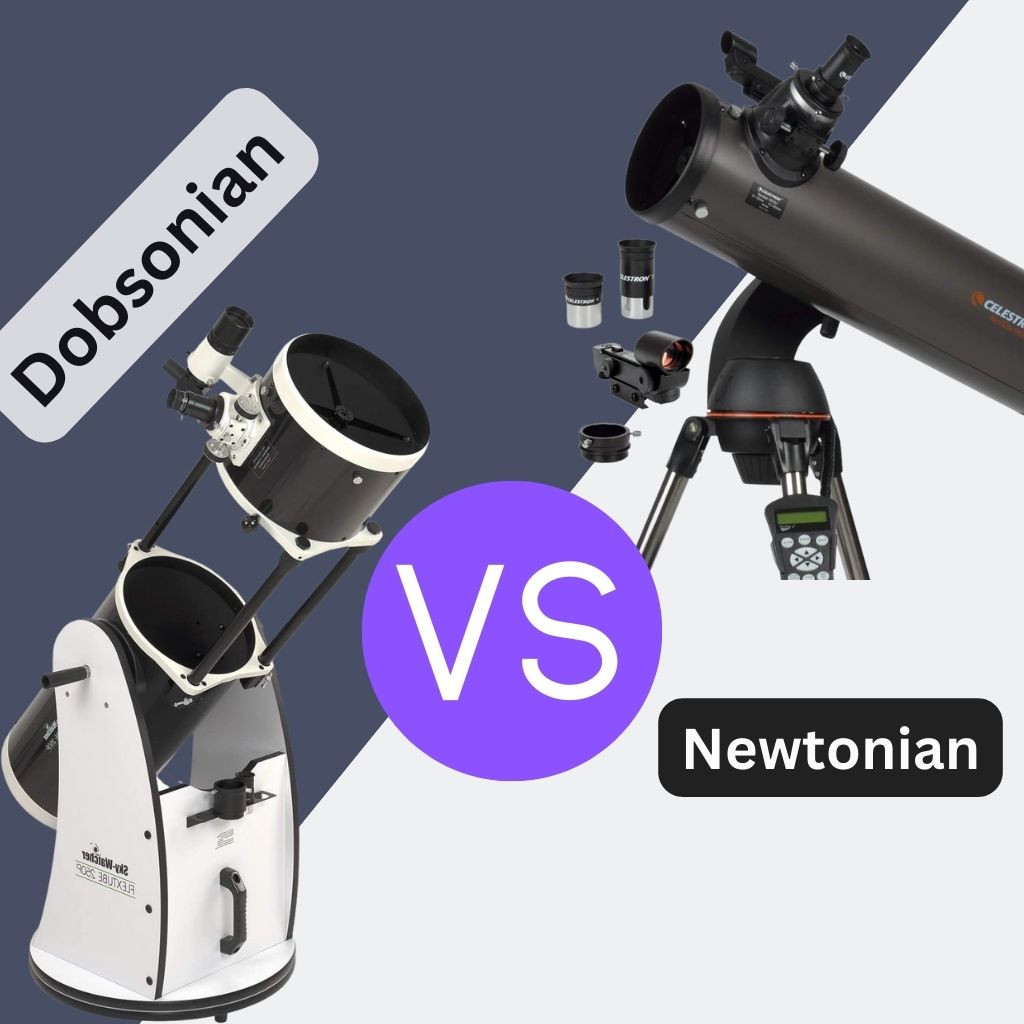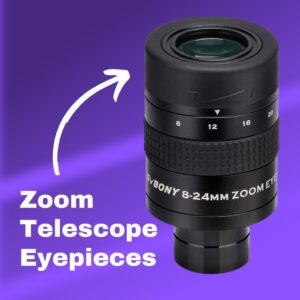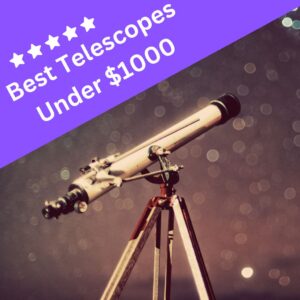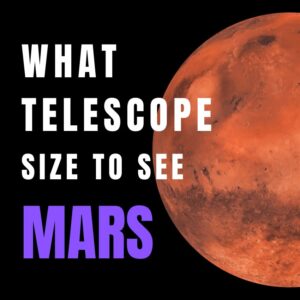This site contains affiliate links to products. I may receive a commission for purchases made through these links.
Among the various types of telescopes available, two popular options often stand out: the Dobsonian and the Newtonian telescopes.
These instruments, named after their respective inventors, John Dobson and Sir Isaac Newton, offer unique advantages and cater to different needs in the world of astronomy.
Both are types of reflector telescopes that use mirrors to collect and focus light, offering impressive views of celestial objects.
If you’re a seasoned stargazer or a budding astronomer, understanding the differences between these two telescope designs is crucial in making an informed choice.
In this article, we delve into the distinctions between Dobsonian and Newtonian telescopes, unraveling their features, benefits, and applications.
Dobsonian telescope vs Newtonian telescope: Brief overview
The world of amateur astronomy opens up when you start understanding the different types of telescopes available.
Two common types that you may encounter are the Dobsonian and the Newtonian telescopes.
Let’s quickly glance over what each of these telescopes represents.
| Dobsonian Telescope | Newtonian Telescope | |
| Design origin | Developed by John Dobson in the 1960s | Invented by Sir Isaac Newton in the 17th century |
| Mount style | Altitude-Azimuth (Alt-Az) mount, also known as the Dobsonian mount | Typically Equatorial or Alt-Az mount |
| Primary use | Deep-sky observation (nebulas, galaxies, star clusters). | Both planetary/lunar and deep-sky observation. |
| Ease of use | Simple and user-friendly, ideal for beginners | Requires some learning, especially for equatorial mounts. |
| Portability | Large sizes can be less portable | Depends on size, but generally more portable |
Differences between a Dobsonian and Newtonian reflecting telescope
A Dobsonian telescope is essentially a type of Newtonian telescope that has been modified for easier handling and portability, especially for larger apertures.
Let’s delve into the nuances that set them apart.
1. Dobsonian telescopes feature a user-friendly Alt-Azimuth (Alt-Az) mount, while Newtonian telescopes commonly employ Equatorial mounts
Dobsonian telescopes employ a simple Alt-Azimuth (Alt-Az) mount, also known as the Dobsonian mount. This mount moves up-down and left-right, making it intuitive and easy for beginners.
On the other hand, Newtonian telescopes often use Equatorial mounts which can track celestial objects across the sky but require Polar alignment, which can be challenging for beginners.
You may also like: How to Use a Dobsonian Telescope (Beginners Guide)
2. Dobsonian telescopes offer larger apertures with reasonable portability, while Newtonian telescopes prioritize portability
Due to their simple mount, Dobsonian telescopes can have a large aperture and still remain somewhat portable and easy to assemble. However, the larger the Dobsonian, the less portable it becomes.
Newtonian telescopes, especially those on an equatorial mount, are generally more portable, but the mounts can be heavy and difficult to set up.
3. Dobsonian telescopes are more cost-effective than Newtonian telescopes, especially the ones with quality equatorial mounts
Dobsonian telescopes provide more aperture per dollar, making them a cost-effective choice for viewing faint objects in the night sky. But Newtonian telescopes, particularly those with quality equatorial mounts, can be more expensive.
4. Dobsonian telescopes excel in deep-sky viewing, while Newtonian telescopes offer versatility for planetary/lunar and deep-sky observations
Dobsonian telescopes are highly popular for deep-sky viewing, making them an excellent choice for observing nebulae, galaxies, and star clusters.
However, Newtonian telescopes are versatile and can be used for both planetary/lunar and deep-sky observations.
5. Mirror quality and collimation play vital roles in the performance of both Dobsonian and Newtonian telescopes, with collimation being particularly crucial for Newtonian telescopes
Unlike a refracting telescope, which uses lenses, both Dobsonian and Newtonian telescopes utilize mirrors to focus incoming light. A refractor telescope uses lenses instead of mirrors to gather light.
While both Dobsonian and Newtonian telescopes rely on primary and secondary mirrors for light collection and focusing, the optical performance can differ based on the quality of the mirrors and the precision of collimation, which is particularly crucial in Newtonian telescopes.
You may also like: How To Collimate Mirrors On Newtonian Reflector
Dobsonian telescope overview
Dobsonian telescopes, fondly called “Dobs,” are a favorite among many amateur astronomers due to their simplicity, cost-effectiveness, and outstanding deep-sky observation capabilities.
Can I view planets with a Dobsonian telescope?
You can view planets with a Dobsonian telescope. While they are best known for deep-sky observations, Dobsonian telescopes can still provide pleasing views of planets, especially the larger ones such as Jupiter and Saturn.
Can I view galaxies with a Dobsonian telescope?
One of the key strengths of a Dobsonian telescope is its prowess in observing faint deep-sky objects such as galaxies. With a larger aperture, a Dobsonian can gather more light, enabling you to view distant galaxies and nebulae that are challenging to see with other telescopes.
Can I view the sun with a Dobsonian telescope?
Technically, you can view the Sun with a Dobsonian telescope, but it should never be attempted without proper solar filters. Looking at the sun directly through a telescope can result in severe and permanent eye damage.
Can I take photos of celestial objects with a Dobsonian telescope?
While Dobsonian telescopes are not typically designed for astrophotography, with the right equipment and some experience, it is possible to take pictures of celestial objects.
Due to the Alt-Az mount’s design, Dobsonians are more suitable for short-exposure astrophotography, such as lunar and planetary imaging.
Features of a Dobsonian telescope
Here are some of the common features of Dobsonian telescopes:
Simplicity and ease of use
Dobsonians are designed for easy and intuitive use, making them an excellent choice for beginners in amateur astronomy.
Large aperture
Dobsonian telescopes are often praised for their large apertures. The large aperture allows them to collect more light, providing brighter and more detailed views of celestial objects.
Cost-effectiveness
In terms of cost per inch of aperture, Dobsonian telescopes are some of the most affordable options available, making them an excellent choice for those looking for a budget-friendly telescope.
Advantages of a Dobsonian telescope
Let’s explore some of the benefits of this telescope type
Large aperture at a low cost
One of the biggest advantages of a Dobsonian telescope is that it offers a large aperture at a comparatively low cost. This makes it ideal for those who want to delve into deep-sky observing without spending a fortune.
Ease of use
The simple Alt-Az mount and intuitive design make Dobsonian telescopes easy to set up and use, even for beginners.
Versatility
While they excel at deep-sky viewing, Dobsonians can also be used for observing the Moon, planets, and even the Sun (with appropriate filters).
Limitations of a Dobsonian telescope
While Dobsonian telescopes offer several advantages, they also have a few downsides, such as:
Heavyweight
Larger Dobsonians can be quite heavy and cumbersome, making them less portable and more difficult to store.
Not ideal for astrophotography
Due to the design of the Alt-Az mount, Dobsonian telescopes are not ideal for long-exposure astrophotography, which requires a telescope to precisely track the motion of the sky.
Regular maintenance
The open design of a Dobsonian means that the mirrors may collect dust and require regular cleaning. They may also require regular collimation (alignment of the mirrors) to deliver the best viewing experience.
You may also like: 5 Advantages and Disadvantages of Dobsonian Telescopes
Best Dobsonian telescopes
When selecting a Dobsonian telescope, it’s essential to consider your specific observing interests, budget, and skill level.
Here are some recommended models:
The Sky-Watcher GoTo Collapsible Dobsonian 8-Inch telescope – Best for lunar and planetary observation
Sky-Watcher GoTo Collapsible Dobsonian 8-Inch telescope is a versatile and user-friendly instrument that combines the convenience of a collapsible design with the advanced features of a GoTo system.
This telescope offers an 8-inch aperture, providing impressive light-gathering capabilities for detailed observations of celestial objects.
The GoTo functionality allows for automated object tracking, making it ideal for both beginners and experienced astronomers who want to effortlessly navigate the night sky.
With its collapsible design, it is also highly portable, making it convenient for stargazing adventures on the go.
Orion SkyQuest XT8 Dobsonian Reflector Telescope – Best for beginners
The Orion SkyQuest XT8 Classic Dobsonian Telescope is a renowned and reliable instrument that offers impressive views of the night sky.
Dobsonian telescope excels at capturing ample light, making it ideal for observing a wide range of celestial objects, including planets, nebulae, and galaxies.
Its sturdy and straightforward design ensures ease of use, making it suitable for beginners and seasoned astronomers alike.
The XT8 Classic Dobsonian is known for its excellent optics, providing sharp and detailed views of astronomical targets.
Read the complete review: Orion SkyQuest XT8 Review (#1 Beginner Telescope)
Sky-Watcher Flextube 300 Dobsonian SynScan Telescope – Best Dobsonian telescope for deep sky objects
If your primary interest lies in observing faint, deep-sky objects like galaxies and nebulae, the Sky-Watcher Flextube 300 Dobsonian SynScan is a fantastic choice.
Its whopping 12-inch aperture can gather a lot of light, giving you bright and highly detailed views of distant celestial objects.
The SynScan computerized system will guide you to thousands of wonders in the night sky, making this the ultimate Dobsonian for deep-sky enthusiasts.
Newtonian telescope overview
These types of telescopes, pioneered by Sir Isaac Newton, have had a significant impact on the field of amateur astronomy due to their simple yet efficient design.
Their relatively short focal length and wide field of view make them well-suited for capturing expansive star fields, nebulae, and star clusters.
The design of Newtonian telescopes also lends itself to easy maintenance and collimation, ensuring optimal performance over time.
Can I view planets with a Newtonian telescope?
A Newtonian telescope is more than capable of providing clear views of planets. The primary mirror collects light from the object and reflects it to a secondary mirror, which then directs the light into the eyepiece.
The resulting images of planets are bright and full of detail, making Newtonian reflectors a favorite among many amateur astronomers for planetary viewing.
Can I view galaxies with a Newtonian telescope?
Newtonian telescopes, particularly those with larger apertures, are excellent for observing galaxies. The larger the telescope’s aperture, the more light it can gather, allowing for brighter and more detailed views of faint objects like distant galaxies.
Can I view the sun with a Newtonian telescope?
Much like Dobsonians, you can technically view the sun with a Newtonian telescope, but it’s crucial to use a proper solar filter. Observing the sun without one can lead to severe eye damage.
It’s also important to note that not all solar filters are created equal, so make sure you get one specifically designed for your telescope’s aperture and made by a reputable manufacturer, such as Thousand Oaks Optical Solar Filter.
Always prioritize your safety when observing the sun, and choose a trusted solar filter that meets the necessary specifications for your Newtonian telescope.
Can I take photos of celestial objects with a Newtonian telescope?
Newtonian telescopes are quite popular in the field of astrophotography, particularly for their ability to produce bright and high-contrast images.
While it’s often recommended to have a motorized equatorial mount for long-exposure astrophotography, many amateurs have created stunning images using Newtonian telescopes.
Features of a Newtonian telescope
Here are some of the common features of a Newtonian telescope:
Simple and efficient design
The design of a Newtonian telescope is simple but effective, with a primary concave mirror at the back of the optical tube and a flat secondary mirror near the front.
Affordability
Like Dobsonians, Newtonians also offer a large aperture at a lower cost compared to other telescope types, making them an affordable option for amateur astronomers.
Excellent image quality
Due to their design, Newtonians are free from chromatic aberration, a type of distortion found in refracting telescopes. This results in high-quality and high-contrast views of celestial objects.
Advantages of a Newtonian telescope
Let’s address some of the pros of this telescope.
Good for deep-sky and planetary observing
Newtonian telescopes are excellent for both planetary and deep-sky observing, thanks to their large apertures and high-quality optics.
Cost-effective
Given their simple design, Newtonians offer a lot of aperture for the money, making them an economical choice for those wanting to observe faint, deep-sky objects.
Good for astrophotography
With a motorized equatorial mount, a Newtonian can be a powerful tool for astrophotography, allowing for detailed, long-exposure images of a wide variety of celestial objects.
Limitations of a Newtonian telescope
Here are some of the cons of this telescope:
Requires regular maintenance
Like Dobsonian telescopes, Newtonians are open-tube designs, meaning they may require regular cleaning and collimation to maintain optimal performance.
Coma aberration
Newtonian telescopes, similar to other reflecting telescope designs that utilize parabolic mirrors, experience a limitation known as coma aberration.
Coma manifests as imagery flaring inward and toward the optical axis, causing stars located at the edges of the field of view to appear comet-like in shape.
Best Newtonian telescopes
Choosing a Newtonian telescope, like any other telescope, depends on several factors, including the budget, experience level, and observing interests.
Here are some of the best telescopes in this model:
Celestron NexStar 130SLT Computerized Telescope – Best for planetary viewing
The Celestron NexStar 130SLT is not just a Newtonian reflector; it’s a sophisticated astronomical tool that blends optical prowess with modern technology.
Its 130mm aperture, combined with fully coated glass optics, ensures bright, clear images of planets, star clusters, and more distant galaxies.
Additionally, the computerized “GoTo” alt-azimuth mount with a database of over 40,000 celestial objects makes finding and tracking any celestial body a breeze.
The SkyAlign technology also offers an effortless alignment process, making this telescope ideal for those particularly interested in planetary observation.
Orion AstroView 6 Equatorial Reflector Telescope – Best for astrophotography
For the budding astrophotographer, the Orion AstroView 6 Equatorial Reflector Telescope is a solid choice. Its 6-inch aperture, coupled with the equatorial mount, provides a gateway into the world of astrophotography.
The scope collects enough light to reveal a wealth of details in celestial objects while the equatorial mount’s smooth tracking facilitates long-exposure photography, essential for capturing beautiful images of galaxies, nebulae, and star fields.
The telescope also comes with two Sirius Plossl 1.25″ eyepieces and a 6×30 finder scope to further enhance your astrophotography journey.
Celestron Advanced VX 8″ Newtonian Telescope-Best for deep sky observation
The Celestron Advanced VX 8″ Newtonian Telescope has several noteworthy features that make it a desirable option for intermediate and advanced astronomers.
Its sturdy equatorial mount provides stability and smooth tracking, allowing for precise and accurate observations of celestial objects.
The 8-inch aperture ensures remarkable light-gathering capability, enabling detailed views of planets, nebulae, galaxies, and star clusters.
The telescope’s versatile nature makes it suitable for both planetary observations, with the ability to capture fine details on the surfaces of celestial bodies, as well as deep-sky observations, where it reveals the intricate beauty of distant objects.
Dobsonian vs. Newtonian telescopes, which is better?
Determining which is better between Dobsonian and Newtonian telescopes is not a straightforward task, as it largely depends on personal preferences, observing goals, and individual circumstances.
Dobsonian telescopes excel in providing large apertures at an affordable price, making them ideal for deep-sky observations and revealing faint celestial objects.
They are user-friendly, with simple Alt-Azimuth mounts that are easy to operate and navigate, particularly suited for beginners.
On the other hand, Newtonian telescopes offer versatility for both planetary and deep-sky observations, with the potential for sharper and more detailed images.
Equipped with equatorial mounts, they can track celestial objects across the sky, compensating for Earth’s rotation.
However, these mounts require polar alignment, which can be challenging.
Is a Dobsonian telescope better for beginners than Newtonian telescopes?
For beginners, a Dobsonian telescope generally provides an easier entry point into the world of astronomy.
The simple alt-azimuth mount is intuitive to use and requires less setup and calibration than an equatorial mount typically found with Newtonian telescopes.
Furthermore, Dobsonians are known for their larger apertures at lower costs, which allows beginners to see more detailed views of celestial objects without breaking the bank.
Is a Dobsonian better for astrophotography than Newtonian telescopes?
A Newtonian telescope on an equatorial mount is generally a more suitable choice. The equatorial mount’s ability to track celestial objects smoothly across the night sky is critical for long-exposure photography, allowing astrophotographers to capture more detailed and less blurry images of celestial objects.
While Dobsonian telescopes provide excellent views for visual observation, their mounts are not ideal for tracking objects, making them less suited for astrophotography.
Which telescope, Dobsonian or Newtonian, is better for deep-space observations?
Both Dobsonian and Newtonian telescopes can provide excellent views of deep-space objects, given their common heritage of a Newtonian reflector design.
However, Dobsonians often come with larger apertures for the same price range, meaning they can gather more light and provide brighter, more detailed views of faint, deep-space objects.
Therefore, for purely visual deep-space observations, a Dobsonian might be the preferred choice.
You may also like: 9 Best Deep Space Telescopes (Ranked!)
FAQs
Navigating the world of telescopes raises a lot of questions. Here are the answers to some of the most frequently asked ones:
Can I view Uranus with an 8-inch Dobsonian telescope?
Uranus can be viewed with an 8-inch Dobsonian telescope. However, given the planet’s great distance from Earth, it will appear as a small, faint disk even through a large telescope.
The use of high-quality eyepieces and ideal viewing conditions (clear, dark skies with no light pollution) can improve the viewing experience.
Can you track objects with a Dobsonian?
You can track objects with a Dobsonian telescope, but it requires manual adjustment. The simple alt-azimuth mount of a Dobsonian allows for easy movement in the vertical (altitude) and horizontal (azimuth) directions.
However, unlike an equatorial mount found on many Newtonian telescopes, it doesn’t automatically track the motion of celestial objects across the sky.
Therefore, when observing with a Dobsonian, you’ll need to manually adjust the telescope to keep objects in view.
Takeaway: Dobsonian telescopes prioritize affordability and simplicity, while Newtonian telescopes offer versatility and optical performance
Reflecting telescopes, including Dobsonian and Newtonian designs, have revolutionized amateur astronomy by providing high-quality, detailed views of the night sky at relatively affordable prices.
Dobsonian telescopes, with their large apertures and user-friendly design, offer a superb choice for beginners and those interested in deep-space observations.
On the other hand, Newtonian reflector telescopes, especially those on an equatorial mount, can be more suitable for budding astrophotographers due to their ability to track celestial objects smoothly across the sky.
Regardless of your choice, both Dobsonian and Newtonian telescopes are excellent tools for unveiling the secrets of the night sky, each with its strengths and unique offerings.
While both telescope types have their benefits and drawbacks, understanding these will ensure you choose the right telescope to suit your stargazing needs and experience level.
You may also like:
- Schmidt-Cassegrain vs. Newtonian Telescopes: A Comprehensive Comparison
- Schmidt-Cassegrain vs Dobsonian: A Guide
- 10 Reasons Why Dobsonian Telescopes Are Cheaper
- 10 Best Dobsonian Telescopes (Ranked!)
- Types of Telescopes & Their Uses (w/ Expert Recommendations)
- Top 3 Sky-Watcher 10-inch Dobsonian Telescopes
- Maksutov Newtonian Telescopes (In-depth Guide)










